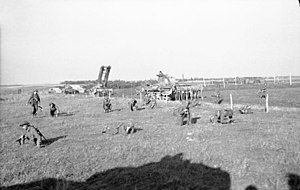| Operation Astonia | |||||||
|---|---|---|---|---|---|---|---|
| Part of The Western Front in the Second World War | |||||||
 Churchill bridgelayers, Shermans and infantry following the assault on Le Havre, 13 September 1944 | |||||||
| |||||||
| Belligerents | |||||||
|
|
| ||||||
| Commanders and leaders | |||||||
|
|
| ||||||
| Strength | |||||||
| |||||||
| Casualties and losses | |||||||
|
388–500 40 armoured vehicles |
600 killed 11,300 captured | ||||||
| 5,000 French civilians killed [1] | |||||||
Operation Astonia was the codename for an Allied attack on the German-held Channel port of Le Havre in France, during the Second World War. The city had been declared a Festung (fortress) by Hitler, to be held to the last man. Fought from 10 to 12 September 1944, the Allied objective was to secure the harbour facilities intact, to deliver supplies to the Allied armies in Continental Europe. The Allies refused to let the civilian population be evacuated, despite offers of free passage by the fortress commander.
From 26 August, Royal Navy ships and Royal Air Force aircraft carried out a blockade and an extensive preparatory bombardment of the city, which killed over 2,000 civilians and 19 German troops. The land attack was carried out by British infantry, aided by specialist armoured vehicles from the 79th Armoured Division, including Canadian troops. The German garrison of about 11,000 men surrendered on 12 September; the port was badly damaged but it was re-opened on 9 October.